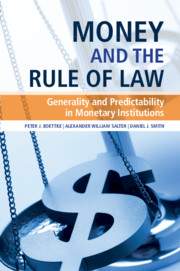Book contents
- Money and the Rule of Law
- Money and the Rule of Law
- Copyright page
- Dedication
- Contents
- Preface
- Acknowledgments
- 1 Introduction
- 2 Knowledge Problems with Discretionary Monetary Policy
- 3 Incentive Problems with Discretionary Central Banking
- 4 When Firefighters Are Arsonists
- 5 On the Shoulders of Giants
- 6 Money and the Rule of Law
- 7 Conclusion
- Index
- References
5 - On the Shoulders of Giants
Monetary Policy Insights of the Classically Liberal Nobel Laureates
Published online by Cambridge University Press: 13 May 2021
- Money and the Rule of Law
- Money and the Rule of Law
- Copyright page
- Dedication
- Contents
- Preface
- Acknowledgments
- 1 Introduction
- 2 Knowledge Problems with Discretionary Monetary Policy
- 3 Incentive Problems with Discretionary Central Banking
- 4 When Firefighters Are Arsonists
- 5 On the Shoulders of Giants
- 6 Money and the Rule of Law
- 7 Conclusion
- Index
- References
Summary
At root, the problems with the Federal Reserve (and many other central banks) are institutional. The repeated recessions and crises in the era of the Fed show that we need a radical reimagination of the basic institutions of monetary policy. In this chapter, we survey the work of the three great classically liberal Nobel laureates of the twentieth century – James Buchanan, F. A. Hayek, and Milton Friedman – to show that each of them gave serious consideration to monetary-institutional fundamentals. Our focus is not on their particular conclusions, but on how they thought about the problems of monetary institutional design. This represents a very different style of scholarship than macroeconomists and monetary economists currently practice. Unless scholars engage the research projects of Buchanan, Hayek, and Friedman, research in monetary economics will not be of much help in achieving lasting macroeconomic stability.
Keywords
- Type
- Chapter
- Information
- Money and the Rule of LawGenerality and Predictability in Monetary Institutions, pp. 125 - 145Publisher: Cambridge University PressPrint publication year: 2021



